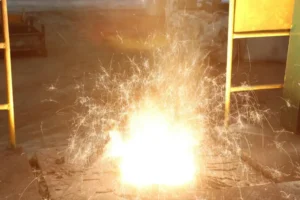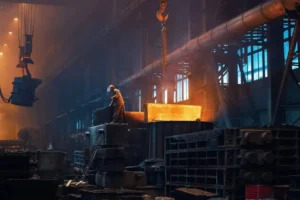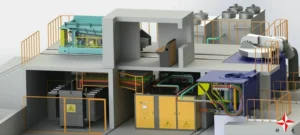In industrial production, especially in high-energy-consuming and high-emission industries like casting and metallurgy, the energy-saving and environmental performance of medium frequency induction furnaces (MF furnaces) is critically important. The points you’ve raised are very comprehensive; let’s elaborate on each one.
I. Energy Efficiency Improvement
The primary energy consumption of MF furnaces is electricity, so improving energy efficiency is at the core of energy saving.
1. New Power Supply Technology: Promoting efficient IGBT power supplies to reduce electricity loss.
- In-depth Analysis: Traditional thyristor (SCR) MF power supplies suffer from issues like high harmonic content, low power factor, and significant grid pollution. In contrast, IGBT (Insulated Gate Bipolar Transistor) power supplies offer advantages such as high switching frequency, fast response, low harmonic content, high power factor, and high conversion efficiency.
- Energy Saving Principle: IGBT power supplies achieve lower conversion losses from electrical energy to medium-frequency electrical energy through higher switching frequencies and more precise PWM (Pulse Width Modulation) control. Additionally, their power factor is close to 1, reducing reactive power losses and lessening the burden on the grid.
- Development Trend: As IGBT technology advances, its voltage and current capabilities continue to improve, and costs gradually decrease, making IGBT MF power supplies the market mainstream. They are also moving towards higher power and more integrated designs.
- Case Study: Many casting enterprises have achieved 20% or even greater electricity savings by upgrading their older thyristor power supplies to IGBT power supplies.
2. Intelligent Control Systems: Achieving precise control of power and temperature, reducing overheating and energy waste.
- Control Strategy: Intelligent control systems typically use PLCs (Programmable Logic Controllers) or industrial PCs as their core, combined with advanced control algorithms (such as PID control, fuzzy control, neural network control, etc.) to achieve precise management of the melting process.
- Energy Saving Manifestations:
- Melting Curve Optimization: Setting the optimal heating curve based on the melting point and characteristics of different metal materials, avoiding unnecessary overheating, and shortening melting time.
- Automatic Power Regulation: Automatically adjusting the output power based on the molten metal state and temperature changes in the furnace, ensuring heating at optimal efficiency. For example, high power can be used for rapid heating during the initial melting phase, while power is reduced during the later melting and holding phases to maintain the desired temperature.
- Holding Energy Saving: During the holding phase, intelligent systems can implement intermittent heating or low-power constant temperature to reduce heat loss.
- No-load Energy Saving: When the furnace is idle, the system automatically reduces or shuts off power to avoid no-load losses.
- Data Analysis and Optimization: Intelligent control systems can record and analyze historical melting data, providing a basis for process optimization to further improve energy efficiency.
3. Heat Recovery Technology: Exploring the utilization of waste heat for preheating or power generation, increasing energy utilization.
- Waste Heat Sources: During MF furnace operation, in addition to the heat of the molten metal itself, potential waste heat sources include heat dissipated from the furnace body surface, heat carried away by cooling water, and heat carried by melting fumes.
- Recovery Methods:
- Furnace Body Radiant Heat Recovery: Recovering heat lost from the furnace body by installing insulation layers or using heat exchangers on the exterior, for purposes like workshop heating or preheating other materials.
- Cooling Water Heat Recovery: The cooling water from MF furnaces (especially from the induction coils) can reach high temperatures. Heat pump technology can elevate this heat to higher temperatures for domestic hot water, workshop heating, or preheating furnace charge.
- Flue Gas Waste Heat Recovery: High-temperature melting fumes can be used in waste heat boilers to generate steam for other production processes or power generation.
- Application Prospects: Heat recovery technology can significantly improve the overall energy utilization rate of MF furnaces, reduce operating costs for enterprises, and is a crucial direction for future MF furnace energy saving.
II. Pollutant Emission Control
MF furnaces generate dust, noise, and wastewater during the melting process. Effective pollutant control is key to achieving environmentally friendly production.
1. Fume and Dust Control: Employing negative pressure dust collection, bag filters, and other technologies to effectively remove fumes and dust generated during melting.
- Fume and Dust Sources: During melting, impurities in the charge, volatilization of alloying elements, burning loss of refractory linings, and metal oxidation all generate significant amounts of fumes and dust.
- Control Technologies:
- Furnace Mouth Hoods: This is the first line of defense, using negative pressure to collect fumes and dust generated during melting above the furnace opening.
- Ducting: Collected fumes are transported through ducts to the dust removal system.
- Dust Collectors:
- Bag Filters (Fabric Filters): Currently one of the most widely used and efficient dust collection devices. As fumes pass through the filter bags, dust is trapped on the bag surface. Regular cleaning removes the dust into a hopper. Their dust removal efficiency can reach over 99%, effectively capturing fine particulate matter like PM2.5.
- Cyclone Separators: Primarily used for removing larger dust particles, often employed as pre-collectors in conjunction with bag filters.
- Wet Scrubbers: Capture dust through a water wash process, but generate wastewater.
- System Optimization: Rational design of suction volume, duct layout, and selection of dust collectors ensure that the dust removal effect meets national environmental standards.
2. Noise Control: Reducing equipment operating noise through sound insulation, vibration damping, and other measures.
- Noise Sources: The main noise sources of MF furnaces include:
- Power Cabinets: Electromagnetic noise and mechanical noise from transformers, reactors, and fans.
- Cooling Water Pumps: Mechanical noise generated by pump operation.
- Induction Coils: Electromagnetic vibration noise caused by harmonic currents.
- Tilting Mechanisms: Mechanical friction and hydraulic system noise during tilting.
- Control Measures:
- Source Control: Selecting low-noise equipment and implementing sound insulation for power cabinets, such as installing soundproof enclosures or walls.
- Transmission Path Control:
- Sound Insulation: Installing sound barriers, soundproof doors and windows around noise sources, or placing equipment in separate soundproof rooms.
- Sound Absorption: Installing sound-absorbing materials on workshop walls and ceilings to reduce noise reflection.
- Vibration Damping: Installing vibration isolation pads and dampers on equipment foundations and connections to reduce vibration transmission.
- Personal Protective Equipment (PPE): Providing operators with earplugs, earmuffs, and other PPE.
3. Water Resource Recycling: Promoting closed-loop cooling systems to reduce water consumption and wastewater discharge.
- Cooling Water Demand: MF furnace power components, induction coils, and other parts generate significant heat during operation, requiring cooling water to dissipate it and ensure normal equipment operation and lifespan.
- Problems with Traditional Open Systems: Traditional open cooling systems (where water is directly drawn from a source for cooling and then discharged) suffer from high water waste, susceptibility to water quality pollution, proneness to scaling, and pipe corrosion.
- Closed-Loop Cooling System Principle: Closed-loop cooling systems use circulating cooling water. Heat from the cooling water is dissipated into the atmosphere via cooling towers or chillers, and the cooled water is then recirculated back to the equipment for cooling. The water in the system does not directly contact the external environment, ensuring stable water quality and reducing scaling.
- Environmental Benefits:
- Water Conservation: Significantly reduces the need for new water replenishment, achieving water resource recycling.
- Reduced Wastewater Discharge: Virtually no production wastewater discharge, complying with environmental requirements.
- Extended Equipment Lifespan: Stable water quality and temperature help extend equipment lifespan.
III. Green Casting and Sustainable Development
MF furnaces play a crucial role in promoting the casting industry’s transition towards green and intelligent development.
1. Cleaner Production:
- Source Control: Selecting high-quality furnace charge to minimize impurity introduction, thereby reducing fume, dust, and harmful gas generation.
- Process Optimization: Optimizing melting processes through intelligent control systems to reduce over-burning and energy waste, and lower pollutant emissions.
- End-of-Pipe Treatment: Effective fume, dust, noise, and wastewater treatment systems ensure pollutant emissions meet standards.
- Waste Management: Resource utilization or safe disposal of solid waste like furnace slag and dust collection ash.
2. Resource Recycling:
- Scrap Steel Remelting: MF furnaces can efficiently melt scrap steel, making them vital equipment for scrap steel resource recycling and reducing the demand for virgin iron ore.
- Slag Utilization: Exploring comprehensive utilization avenues for furnace slag, such as in construction materials or road filling, to reduce the environmental impact of solid waste.
- Alloy Element Recovery: Employing technical means to recover valuable alloy elements from flue gases in certain melting processes.
3. Intelligent and Digital Transformation:
- Production Data Visualization: Real-time monitoring of MF furnace operating data, utilizing big data analysis to optimize production processes and energy management.
- Predictive Maintenance: Using sensors and algorithms to predict equipment failures, allowing for proactive maintenance, reduced downtime, and improved production efficiency.
- Remote Monitoring and Diagnosis: Enabling remote monitoring, fault diagnosis, and maintenance guidance for equipment via cloud platforms, improving service efficiency.
Through these multifaceted energy-saving and environmental protection measures, MF furnaces can not only enhance their own economic benefits but also support the sustainable development of the casting and related industries, contributing to environmental protection.







